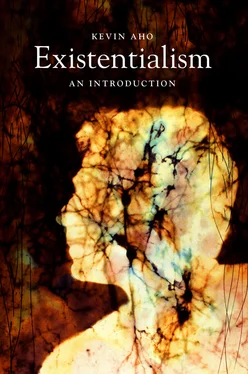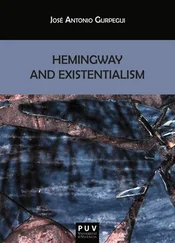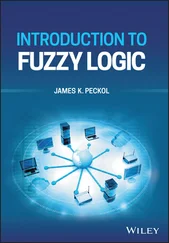Kevin Aho - Existentialism - An Introduction
Здесь есть возможность читать онлайн «Kevin Aho - Existentialism - An Introduction» весь текст электронной книги совершенно бесплатно (целиком полную версию без сокращений). В некоторых случаях можно слушать аудио, скачать через торрент в формате fb2 и присутствует краткое содержание. Год выпуска: 2013, ISBN: 2013, Издательство: Polity, Жанр: Философия, на английском языке. Описание произведения, (предисловие) а так же отзывы посетителей доступны на портале библиотеки ЛибКат.
- Название:Existentialism: An Introduction
- Автор:
- Издательство:Polity
- Жанр:
- Год:2013
- ISBN:978-0745651422
- Рейтинг книги:3 / 5. Голосов: 1
-
Избранное:Добавить в избранное
- Отзывы:
-
Ваша оценка:
- 60
- 1
- 2
- 3
- 4
- 5
Existentialism: An Introduction: краткое содержание, описание и аннотация
Предлагаем к чтению аннотацию, описание, краткое содержание или предисловие (зависит от того, что написал сам автор книги «Existentialism: An Introduction»). Если вы не нашли необходимую информацию о книге — напишите в комментариях, мы постараемся отыскать её.
Existentialism: An Introduction
Existentialism: An Introduction — читать онлайн бесплатно полную книгу (весь текст) целиком
Ниже представлен текст книги, разбитый по страницам. Система сохранения места последней прочитанной страницы, позволяет с удобством читать онлайн бесплатно книгу «Existentialism: An Introduction», без необходимости каждый раз заново искать на чём Вы остановились. Поставьте закладку, и сможете в любой момент перейти на страницу, на которой закончили чтение.
Интервал:
Закладка:
People who were psychotic were given space, they were given company if they wished, or not, and they were given a great deal of physical support if necessary. It was a feature about life at Kingsley Hall that as people were not considered ill, they did not have to be treated. No drugs were to be given to anybody. There were no staff and no patients, and there was no formal structure of doing things around the Hall, yet things got done. There were people who were “up” and people who were “down.” The people who were “up” or capable of functioning in a more usual social sense look after the Hall. (106)
Following Heidegger's notion of ‘liberating solicitude,’ the aim of treatment at Kingsley Hall was to release or free the patients from dehumanizing interventions so that they could face anxiety on their own terms and create their own identity without the reflexive need to conform to what society deemed ‘normal.’ On this view, medication and hospitalization were rejected because they would deny the patient the freedom for this authentic confrontation, to break through the anxiety and ‘become who they are.’
The obvious problem with this approach is that it runs the risk of romanticizing or glorifying anxiety as a “healing experience” and a necessary path to self-realization and personal growth (Barnes and Berke 1971, 86). This is a recurring theme in existentialism, one suggesting that those who suffer the most are the most self-aware and live with increased intensity and passion. They are more artistic, creative, and authentic than others because they fully experience the chaotic anguish of the human situation. Nietzsche famously expresses this romantic sentiment in an oft-quoted line from Thus Spoke Zarathustra : “I tell you: one must still have chaos within oneself, to give birth to a dancing star. I tell you: you still have chaos within you” (2006, I, 5). Or, consider this compelling passage from the Russian existentialist Nikolai Berdyaev:
Not the worst but the best of mankind suffer the most. The intensity with which suffering is felt may be considered an index of a man's depth. The more the intellect is developed and the soul refined … the more sensitive does one become to pain, not only the pains of the soul but physical pains as well. … But for pain and suffering the animal in man would be victorious. (cited in Olson 1962, 28)
There is certainly therapeutic value in recognizing the inescapable pain of being human. But it is questionable whether or not this pain is a sign of a person's creative depth and sensitivity, and whether or not it is always transformative. There are clearly instances of psychic suffering that are so overwhelming, so dangerous, that a medical intervention is necessary. Indeed, Mary Barnes, arguably the most famous patient at Kingsley Hall, nearly died because of the therapeutic attitude of non-interference. In the process of ‘going down’ to confront her anxiety, she would repeatedly cover herself with her own feces, attack her doctors, and eventually stopped eating altogether. Her own psychiatrist, Joseph Berke, “was horrified to see how thin she was, almost like one of those half-alive cadavers the army liberated from Auschwitz” (Barnes and Berke 1971, 228). But Berke and Laing, believing that this was her choice and part of her own process of personal growth, let it go on for some time. The situation eventually reached a point of crisis, where Barnes became “so thin that [they] felt she couldn't even be sent to a hospital, [and that they] might be prosecuted for keeping [her] like that” (Kennard 1998, 107). The staff was forced to intervene and feed her like a baby with milk from a bottle. Barnes survived but her experience exposed the danger of the non-interference aspect of existential therapy.
We can appreciate this problem by going back to the existentialist configuration of the self as a tension between facticity and transcendence. Laing and his colleagues do not deny that there are determinate ‘facts’ about being human, that I am, for instance, a living organism with a unique biochemical signature that shapes my emotional vulnerability. But what distinguishes us from non-human organisms is that we do not simply react to biochemical impulses; we can transcend them by choosing to interpret them in particular ways. I can, for instance, choose to flee from anxiety by taking tranquilizers or by trying to displace it with some objective fear, or I can face it, accept it, and try to integrate it into my life. In either case, the existentialist position makes it clear that I make myself who I am through my free, meaning-giving choices. But the case of Mary Barnes suggests that existential therapists may be overplaying their hand when it comes to transcendence. Indeed, in instances of extreme psychosis, the ability to self-consciously reflect on and give meaning to my emotional state is diminished to such an extent that the very notion of selfhood can be called into question. Consider William Styron's famous description of his own depressive breakdown in his memoir Darkness Visible :
I had reached a phase of the disorder where all sense of hope had vanished, along with the idea of futurity; my brain, in the thrall to its outlaw hormones, had become less an organ of thought than an instrument of registering minute by minute, varying degrees of suffering. … I would lie for as long as six hours, stuporous and virtually paralyzed, gazing at the ceiling and waiting for that moment of evening when, mysteriously, the crucifixion would ease up just enough to allow me to force down some food and then, like an automaton, seek an hour or two of sleep again. (1990, 58)
Styron's words are important because they reveal how out of reach the possibility of self-realization was. By referring to himself as an ‘automaton’ in ‘thrall to its outlaw hormones,’ Styron is clearly suggesting that he was in no way free to take a stand on his condition, that he was actually trapped in facticity. Whereas the existential approach insists that by confronting and accepting anxiety we can eventually break through and realize who we are, in Styron's case this interpretation seems implausible. Indeed, it could be argued that he is no longer a self at all because he does not exhibit the capacity for transcendence (see Aho 2013). And it is at these times when a medical intervention would seem most appropriate. But would this not undermine the therapeutic aim of non-interference, of freeing the patient so they can confront their own nothingness? Not necessarily.
Binswanger writes that the “existential orientation in psychiatry arose from dissatisfaction with the prevailing efforts to gain scientific understanding in psychiatry” (1956, 144). But ‘dissatisfaction’ does not entail the wholesale rejection of scientific approaches. It should entail a rejection of ‘ scientism ,’ a view that Heidegger describes as one where “science alone provides the objective truth. [Where] science is the new religion” (2001, 18). In his own series of seminars with psychiatrists and psychotherapists toward the end of his career, Heidegger makes it clear that mental health professionals are overly influenced by the dogmas of natural science, and this invariably makes them “blind” (59, 75) to their own prejudices as well as to the situated experience of the patient. “Science,” he writes, “is dogmatic to an almost unbelievable degree everywhere, i.e. it operates with preconceptions and prejudices [which have] not been reflected upon. There is the highest need for doctors who think and who do not wish to leave the field entirely to scientific techniques” (103). But for Heidegger, science itself is not the problem. It is the hegemony of the scientific method as the only way to interpret the human situation that is at issue because it reduces the human being to “something chemical and as something which can be affected [only] by chemical interventions” (155). Heidegger's goal in speaking to medical professionals is to liberate them from this reductive assumption so that they can encounter the patient as an existing person , not as a thing. But liberating doctors from reductivism should not preclude the use of psychiatric techniques. If a patient can be pulled out of a state of paralyzing anxiety by means of medication, electroconvulsive therapy, or hospitalization, then medical interventions do not necessarily have to be viewed as dehumanizing and repressive, but as a way of recovering the patient's capacity for transcendence. In spite of the instrumental intervention, the primary aim of existential therapy can remain intact. No longer engulfed in the ‘outlaw hormones’ of facticity, the patient can now begin the hard work of self-realization, of facing anxiety as an existential given, and of integrating an awareness of their own freedom and death into everyday life.
Читать дальшеИнтервал:
Закладка:
Похожие книги на «Existentialism: An Introduction»
Представляем Вашему вниманию похожие книги на «Existentialism: An Introduction» списком для выбора. Мы отобрали схожую по названию и смыслу литературу в надежде предоставить читателям больше вариантов отыскать новые, интересные, ещё непрочитанные произведения.
Обсуждение, отзывы о книге «Existentialism: An Introduction» и просто собственные мнения читателей. Оставьте ваши комментарии, напишите, что Вы думаете о произведении, его смысле или главных героях. Укажите что конкретно понравилось, а что нет, и почему Вы так считаете.












